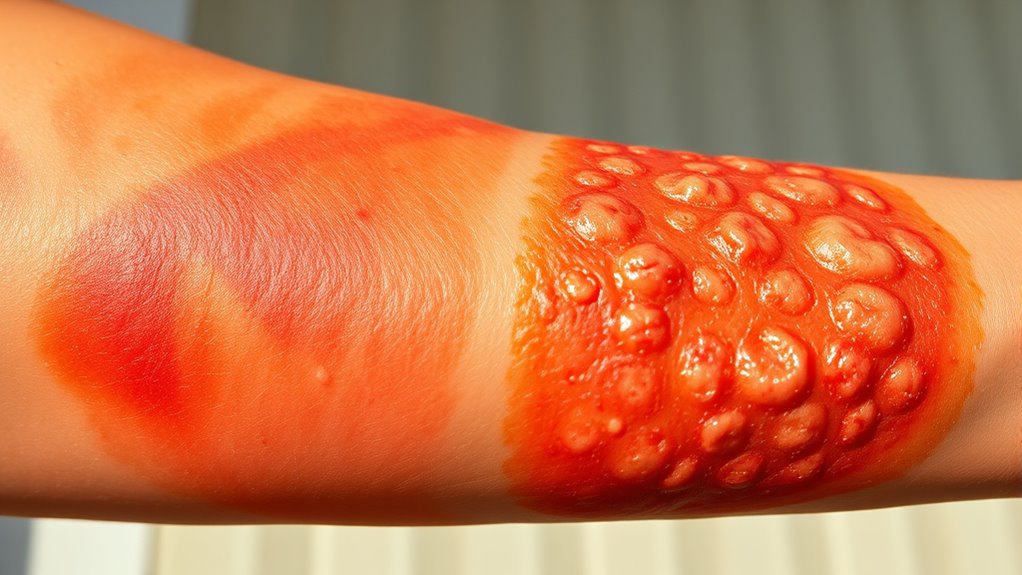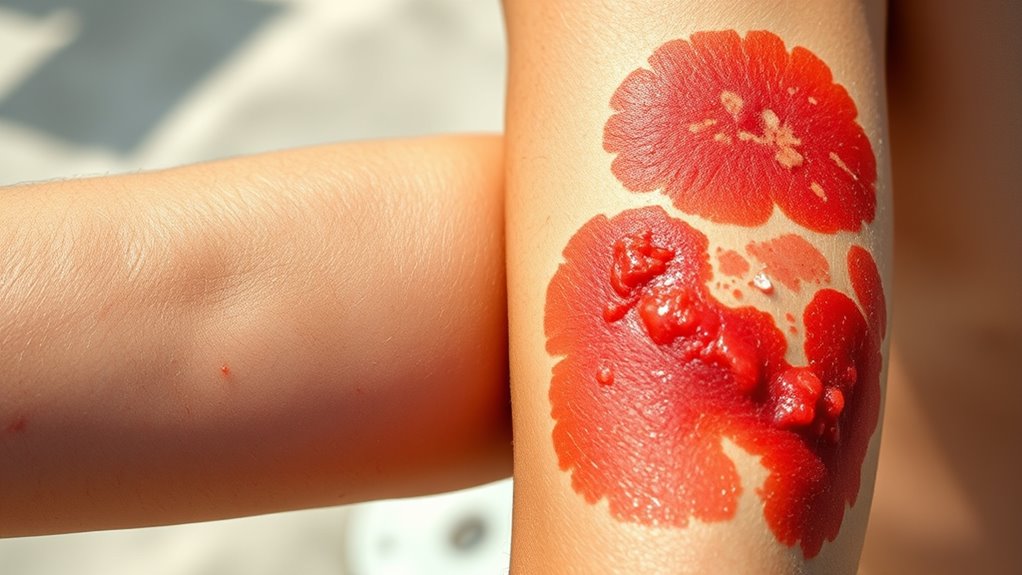Knowing the difference between sunburn and sun poisoning is important for your health. Sunburn causes redness, pain, and blistering on your skin, but usually doesn’t threaten your overall health. Sun poisoning is more severe, with symptoms like fever, chills, nausea, and dehydration, indicating a systemic reaction. Recognizing these signs helps you get the right care and prevents long-term damage. Stick around to find out more about how to tell them apart and why it matters.
Key Takeaways
- Sunburn is a superficial skin reaction causing redness and pain, while sun poisoning involves systemic symptoms like fever and nausea.
- Severity distinguishes them: sunburn is mild; sun poisoning requires urgent medical care for systemic effects.
- Sunburn results from UV damage to skin cells; sun poisoning indicates a harmful body response beyond skin injury.
- Repeated sunburns increase long-term skin damage and cancer risk; sun poisoning can weaken immune health and cause dehydration.
- Recognizing systemic signs helps determine the need for medical attention, emphasizing the importance of proper sun protection.

Many people confuse sunburn and sun poisoning, but they are actually quite different conditions caused by sun exposure. Sunburn is a common skin response that results from overexposure to ultraviolet (UV) rays, leading to redness, pain, and sometimes blistering. It’s primarily a superficial skin reaction, but repeated sunburns can cause long-term tanning effects and significant skin damage. Tanning, in itself, is your skin’s way of trying to protect itself from further UV harm, but it also indicates that your skin has been injured. Over time, this damage accumulates, increasing your risk for premature aging, dark spots, and even skin cancer. So, while a sunburn might seem like a temporary discomfort, it’s actually a sign that your skin has suffered damage at the cellular level. Protecting your skin from further harm is essential to prevent these tanning effects and long-lasting skin damage.
Sun poisoning, on the other hand, is a much more severe and systemic reaction to sun exposure. It’s not just about the skin turning red; it involves a constellation of symptoms that can include fever, chills, nausea, dizziness, and even dehydration. Sun poisoning is often caused by a severe sunburn that’s left untreated or by prolonged or intense UV exposure. Unlike a simple sunburn, which affects only the outer layers of your skin, sun poisoning signals that your body is reacting badly to the sun’s rays. It can sometimes lead to blistering, swelling, and intense pain that lasts for days. If you experience symptoms like fever or chills along with skin redness, it’s a clear sign that you need medical attention. Recognizing the difference between these conditions is *essential* because sun poisoning can have serious health implications beyond just skin damage. It can weaken your immune response, cause dehydration, and, in extreme cases, lead to heatstroke. Being aware that UV rays can penetrate deeply and cause systemic reactions emphasizes the importance of proper sun protection.
Understanding how to tell the difference between sunburn and sun poisoning matters because they demand different levels of care. A mild sunburn can be managed with cool compresses, moisturizers, and staying out of the sun, but sun poisoning might require more urgent medical treatment. Preventing both conditions starts with protecting your skin—using broad-spectrum sunscreen, wearing protective clothing, and avoiding peak sun hours. Remember, repeated sunburns and unchecked skin damage increase your risk of long-term health issues. If you notice symptoms beyond just redness or pain, seek medical advice immediately. Being aware of these differences helps you take the right steps to keep your skin healthy and safe.
Frequently Asked Questions
Can Sun Poisoning Be Life-Threatening?
Yes, sun poisoning can be life-threatening if it causes severe reactions like dehydration, fever, or swelling. You need to seek immediate medical attention in such cases. To prevent this, use sunburn remedies like cool compresses and stay hydrated. Follow sun protection tips like applying broad-spectrum sunscreen and avoiding peak sun hours. Ignoring serious symptoms can worsen your condition, so prioritize your health and get help if needed.
How Long Does It Take for Symptoms to Appear?
Imagine lying in the sun, feeling the warm breeze, and wondering when symptoms might appear. Usually, with sun poisoning, a rash develops within 24 to 48 hours, but some symptoms like fever or nausea can show up sooner or later. The symptom timeline varies based on skin sensitivity and exposure. Keep an eye out, and if you notice a rash development or other troubling signs, seek medical help promptly.
Are Children More Susceptible to Sun Poisoning?
You might wonder if children are more susceptible to sun poisoning. Child vulnerability is real, as their skin is more delicate and less protected against UV rays. That’s why pediatric sun safety is essential; children need proper clothing, sunscreen, and shade. Because their immune systems are still developing, they can react more severely to sun exposure. Taking these precautions helps reduce risks and keeps your child safe in the sun.
Can Sunburn Lead to Skin Cancer?
You might think a sunburn is just a temporary pain, but it can actually set the stage for serious problems! Repeated UV damage from sunburns accelerates skin aging and dramatically increases your risk of skin cancer. Every burn stacks up like a ticking time bomb, so protect your skin, avoid prolonged sun exposure, and remember—what seems minor today could have major consequences tomorrow!
What Are the Best Ways to Prevent Sun Poisoning?
To prevent sun poisoning, you should always apply sunscreen generously and evenly, especially during peak sun hours. Reapply every two hours, or more often if you’re sweating or swimming. Wearing protective clothing like wide-brim hats, sunglasses, and long sleeves adds extra defense. Seek shade whenever possible, and avoid prolonged exposure. These steps help shield your skin from harmful UV rays and reduce the risk of sun poisoning.
Conclusion
Think of your skin as a delicate garden. A sunburn is like a gentle scorch, a warning sign you’ve overwatered or soaked up too much sun. Sun poisoning, however, is a storm that damages the entire garden, leaving it battered and needing care. Recognizing the difference helps you protect your precious bloom. So next time you venture out, listen to your skin’s signals—treat it like your garden, and give it the attention it deserves.








